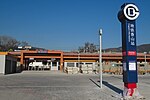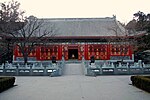China National Botanical Garden station
Beijing Subway stations in Haidian DistrictBeijing Subway stubsRailway stations in China opened in 2017

China National Botanical Garden station (simplified Chinese: 国家植物园站; traditional Chinese: 國家植物園站; pinyin: Guójiā Zhíwùyuán Zhàn), formerly known as Botanical Garden station (simplified Chinese: 植物园站; traditional Chinese: 植物園站; pinyin: Zhíwùyuán Zhàn), is a station on Xijiao line (light rail) of the Beijing Subway. It was opened on 30 December 2017. On April 18, 2022, following the renaming of China National Botanical Garden, the station was renamed to current name.
Excerpt from the Wikipedia article China National Botanical Garden station (License: CC BY-SA 3.0, Authors, Images).China National Botanical Garden station
Haidian District Xiangshan
Geographical coordinates (GPS) Address Nearby Places Show on map
Geographical coordinates (GPS)
| Latitude | Longitude |
|---|---|
| N 39.993582 ° | E 116.214853 ° |
Address
100094 Haidian District, Xiangshan
Beijing, China
Open on Google Maps










